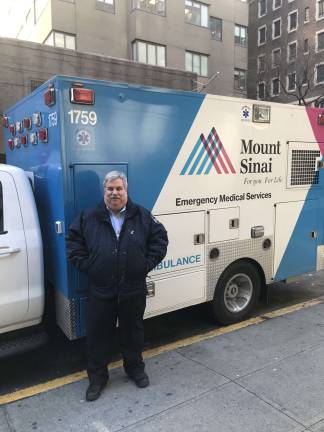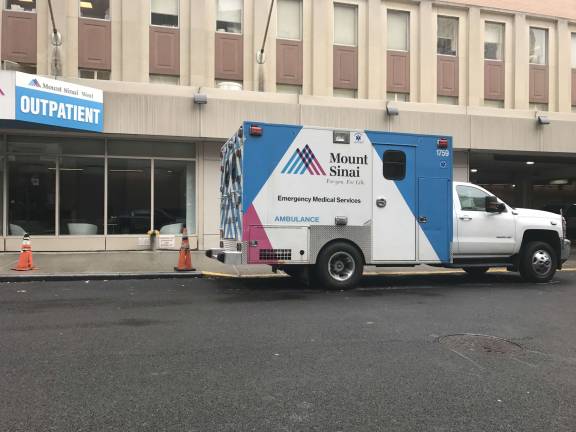the singsong of the siren


Simon and Garfunkel told us about “The Sounds of Silence.” Now, Mount Sinai wants to talk to us again — about the sounds of sirens.
For years, the hospital system fielded complaints about the unpleasant blaring of its ambulances and their unfortunate role in abetting urban noise pollution.
How awful were the sounds? Even the executive responsible for Mount Sinai Health System’s fleet of 24 ambulances calls them “horrible” and “offensive.”
“Our neighbors and pedestrians hated the jarring sounds and the shrieking of the sirens,” said Joseph J. Davis, the director of Emergency Medical Services at the hospital complex.
“It was wailing, it had a quick pitch, and it was very penetrating,” he added. “It’s not just that it was loud. It was piercing. It was ringing in your ears. It was horrible!”
Mount Sinai says it took those complaints to heart. Last September, it devised a far more melodious offering with a lower pitch that has been playing to mostly favorable reviews since it was introduced on October 13th and then phased in over the next several weeks.
Out went the “Wail,” the “Yelp” and the “Piercer.” Yes, those were the actual names for the default settings on the three-position selector switch that Sinai had long used to choose the tone emitted by its sirens, Davis said.
In came the “Hi-Low,” a European-style siren familiar to anyone who has ever strolled a Parisian boulevard. It will still capture the attention of passers-by and induce them to get out of the way, but it’s less likely to grate, annoy or antagonize.
“It still makes the same amount of noise, but it’s no longer an offensive noise,” Davis said. “It cascades up, and then it comes down ... It tapers off. It’s more rhythmic, a lot more pleasant, much less offensive. And all of a sudden, the complaints basically stopped.”
SMILES ON COLUMBUS AVENUE
Count Upper West Side City Council Member Helen Rosenthal and her staffers among those New Yorkers delighted by the reprogramming and the “noticeably lower tones” of the “Hi-Low.”
Consider the scene at 563 Columbus Avenue off West 87th Street:
“Last fall, our staff was working in the district office one afternoon and heard one of the new siren sounds,” she said. “There were huge smiles all around. We are absolutely delighted with this improvement in quality of life for Upper West Side residents — while still maintaining public safety.”
Rosenthal said her office had received a number of constituent complaints about the “frequent, disruptive and high-pitched wails” coming from ambulance sirens. After contacting Sinai, her staff was briefed in mid-September by Davis, who described the Europeanization of Sinai’s siren song.
By October, siren-related constituent complaints had fallen steeply, she said. Significantly, all ambulance sirens still conform to all regulatory requirements, she noted.
“Noise pollution is an often unrecognized but real public health issue,” Rosenthal said. “Mount Sinai has told us that they will continue to work with our office on this issue.”
Initially, Sinai thought the switchover might involve buying new sirens or re-engineering the old ones to new specifications. But as the hospital researched the issue, it turned out to be much simpler.
The siren manufacturer, Connecticut-based Whelen Engineering Co., told executives they could make an internal change to alter the tone, and that they’d always had the capability to choose from 10 possible options, not just the three default tones they’d long been using.
So Davis — who could also have selected the “Woop,” the “Warble” or the “Howler” — opted for the “Hi-Low” instead. Sinai mechanics then removed the sirens, made the modifications, reprogrammed all the settings and reinstalled them.
The bottom line: If not exactly dulcet, the more agreeable tones are now ringing out from two dozen Sinai ambulances that respond to some 86,000 emergency assignments from the city’s 911 system every year.
The fleet operates from four hospital sites in Manhattan, Mount Sinai Hospital, the flagship campus, at Madison Avenue on East 100th Street; Mount Sinai West, at 1000 Tenth Avenue at 59th Street; Mount Sinai St. Luke’s, on 1111 Amsterdam Avenue at 113th Street; and Mount Sinai Beth Israel, on First Avenue at 16th Street.
LOWER FREQUENCY
Of course, the ambulance sirens still generate a lot of noise. “The top output of 118 decibels has not changed,” said Davis, who has run the hospital’s ambulances for 14 years.
What has changed is the fundamental nature of the noise itself in that its frequency is lower, which is akin to a higher quality, even as its intensity, or quantity, remains unchanged.
Sound is measured both by frequency, meaning the speed at which sound waves vibrate as they travel, and intensity, meaning its decibel level, said Arline L. Bronzaft, who studies the adverse effects of noise on health and is a co-author of “Why Noise Matters.”
Think of it in terms of the quality of the music you enjoy: “You can deal with it if it’s a little louder,” Bronzaft said. “But somebody else’s music that you don’t like, you would probably find offensive, even if it was at the same decibel level.”
Thus far, the city’s other hospital systems haven’t replicated the kinder, gentler rhythms of the Sinai ambulance siren, so that, at least for now, it is a singular sound that echoes across the urban landscape.
“It is very distinctive,” Davis says with a measure of pride. “I can always tell when my ambulances are around.”